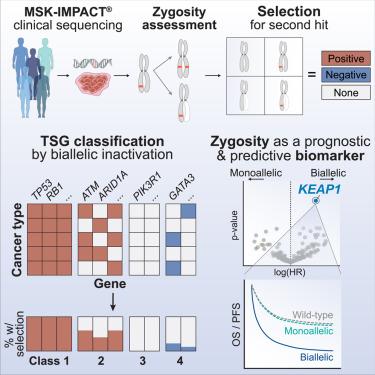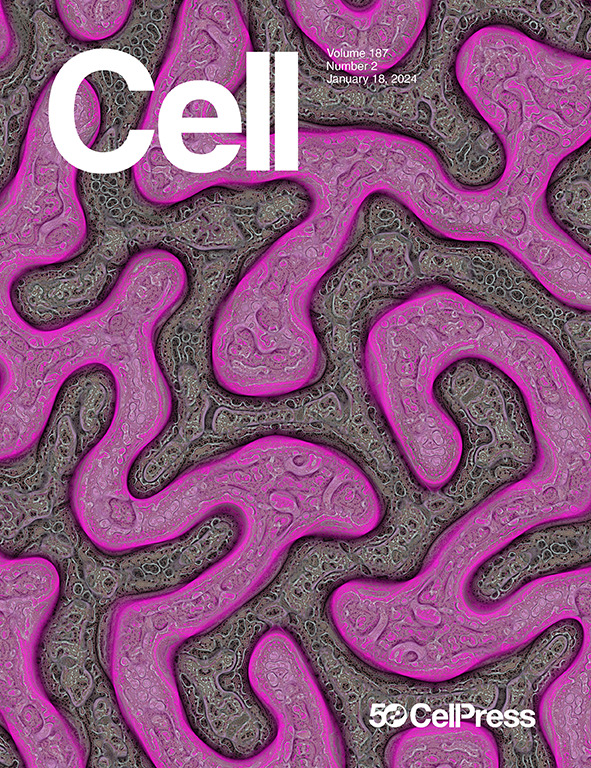肿瘤抑制基因双等位基因失活的泛癌分析发现KEAP1合子性是肺癌的预测性生物标志物
IF 42.5
1区 生物学
Q1 BIOCHEMISTRY & MOLECULAR BIOLOGY
引用次数: 0
摘要
肿瘤抑制基因(TSG)介导的肿瘤发生的典型模型假设两个等位基因的缺失是失活所必需的。通过对48,179名癌症患者的测序数据进行等位基因特异性分析,我们确定了tsg中双等位基因失活的患病率、选择压力和功能后果。尽管一些tsg主要是单等位基因失活(3/4类),但tsg在很大程度上可分为与泛癌(1类)或谱系特异性(2类)双等位基因损失选择模式相关的不同类别。我们证明,双等位基因失活的选择可以用于识别非规范背景下的驱动基因,包括几种tsg(如KEAP1)的未知意义变异(VUSs)。基因组、功能和临床数据共同表明,KEAP1 VUSs表型建立了KEAP1致癌等位基因,并且合子性,而不是变异分类,是预测治疗反应的指标。因此,TSG的合子性是疾病病因和治疗敏感性的基本决定因素。本文章由计算机程序翻译,如有差异,请以英文原文为准。

Pan-cancer analysis of biallelic inactivation in tumor suppressor genes identifies KEAP1 zygosity as a predictive biomarker in lung cancer
The canonical model of tumor suppressor gene (TSG)-mediated oncogenesis posits that loss of both alleles is necessary for inactivation. Here, through allele-specific analysis of sequencing data from 48,179 cancer patients, we define the prevalence, selective pressure for, and functional consequences of biallelic inactivation across TSGs. TSGs largely assort into distinct classes associated with either pan-cancer (Class 1) or lineage-specific (Class 2) patterns of selection for biallelic loss, although some TSGs are predominantly monoallelically inactivated (Class 3/4). We demonstrate that selection for biallelic inactivation can be utilized to identify driver genes in non-canonical contexts, including among variants of unknown significance (VUSs) of several TSGs such as KEAP1. Genomic, functional, and clinical data collectively indicate that KEAP1 VUSs phenocopy established KEAP1 oncogenic alleles and that zygosity, rather than variant classification, is predictive of therapeutic response. TSG zygosity is therefore a fundamental determinant of disease etiology and therapeutic sensitivity.
求助全文
通过发布文献求助,成功后即可免费获取论文全文。
去求助
来源期刊

Cell
生物-生化与分子生物学
CiteScore
110.00
自引率
0.80%
发文量
396
审稿时长
2 months
期刊介绍:
Cells is an international, peer-reviewed, open access journal that focuses on cell biology, molecular biology, and biophysics. It is affiliated with several societies, including the Spanish Society for Biochemistry and Molecular Biology (SEBBM), Nordic Autophagy Society (NAS), Spanish Society of Hematology and Hemotherapy (SEHH), and Society for Regenerative Medicine (Russian Federation) (RPO).
The journal publishes research findings of significant importance in various areas of experimental biology, such as cell biology, molecular biology, neuroscience, immunology, virology, microbiology, cancer, human genetics, systems biology, signaling, and disease mechanisms and therapeutics. The primary criterion for considering papers is whether the results contribute to significant conceptual advances or raise thought-provoking questions and hypotheses related to interesting and important biological inquiries.
In addition to primary research articles presented in four formats, Cells also features review and opinion articles in its "leading edge" section, discussing recent research advancements and topics of interest to its wide readership.
 求助内容:
求助内容: 应助结果提醒方式:
应助结果提醒方式:


